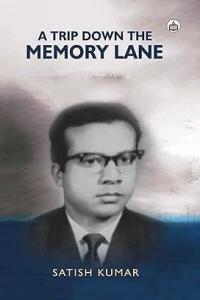Creation and Criticism
ISSN: 2455-9687
(A Quarterly International Peer-reviewed Refereed e-Journal
Devoted to English Language and Literature)
Vol. 08, Joint Issue 28 & 29: Jan-April 2023

Critique
A Trip Down The Memory Lane: A Window to the Past
Anupam Bansal
Prof. Satish Kumar, a distinguished and prolific writer whose works encompass different genres including literary criticism, literary histories, literary essays, philosophic writings and resource material for research, is a renowned figure in the field of Indian Writing in English. His latest book- A Trip Down The Memory Lane is a debut in creative writing. It is an autofiction. The book is divided into seventeen chapters followed by his biodata and a coloured small album depicting various dimensions of his life and making it visually appealing.
In the preface quoting Maya Angelou Prof. Kumar writes," there is no greater agony than bearing an untold story inside you". Then he acquaints the readers with his purpose of writing the memoir. He explains, "so penning down my memories has a cathartic significance which has sobered and chastened my emotional life…I intend relating memories, both sweet and bitter, which recurred time and again and needed an outlet for restoring normal and balanced life. I have also attempted to expose the malaise in society".
The first two chapters,' Amroha My Native Town' and 'Birth and Parentage’ focus on his personal life and show how his native town has moulded his personality and character. It emerges as a powerful character like Hardy's Egdon Heath. The detailed description of streets, schools, colleges, historical monuments, talkies, markets, temples and Mazar of Shah Wilayat Shah imparts the chapter an engaging and enchanting quality.
Chapters three to seven portray the period of author's life that is replete with several life-changing events like professional success, marital bliss, attaining fatherhood and joining of government service etc. In these chapters Prof. Kumar makes an insightful exploration of the most fundamental issues of society like education system, teaching profession and institution of marriage etc. He observes that the students who have been educated in primary education system have a democratic outlook unlike those who study in elite schools these days. He remembers the time when the teachers intended to inculcate humanitarian values and love for our glorious ancient culture in their students. Teachers believed in the dictum that children learn as they play and most importantly in play they learn how to learn.
These chapters also provide a commentary on the problem of orthodoxy and generation gap. Prof. Kumar believes that marriage is a powerful institution that helps a person to face buffets and storms of life courageously. Many challenges and stressful situations that life offers may be encountered with united strength of mutual love. Chapter seven tells about his joining of government service in Gyanpur. Readers are informed about the colleagues and seniors who influenced him in a great way.
Chapter eight " Tehri: The Confluence Of Bhagirathi and Bhilangna" is a beautiful chapter unfolding many memorable experiences of life and initiating his career as a writer. As the title suggests, the chapter is replete with mesmerizing descriptions of natural beauty of Tehri, Mussoorie and Doon Valley etc. It reveals the sensitive and poetical personality of Prof. Kumar. It is remarkable for imaginary flights, poetic charm and emotional depth. Many excerpts from the chapter may be regarded as poems in prose ie," in the morning I reached Rishikesh, a beautiful city in the Himalayan foothills. It's serenity and atmospheric holiness cast a magic spell on me and I enjoyed the morning breeze and the scenic beauty of mountains. I went to Birla Ghat and took bath in the rhythmically flowing Ganga, the holy river."
Chapter nine to thirteen depict the significant period of author's life in higher education, obtaining doctorate in American Literature and publication of numerous best-selling books. In a candid portrayal he unveils the sad spectacle of bribery, corruption and nepotism prevalent in education system. Due to many crooked practices like hypocrisy, avarices and abuse of political power meritocracy is kept aside. Monotonous problems of administration, tribulations for creating infrastructure for teaching and research are shared with the readers. Some colleges are labelled as terrains of academic corruption and mismanagement by Prof. Kumar. As an administrator he faced many challenging situations like mass copying, indiscipline among students and teachers, financial irregularities and abundance of work-shirkers etc.
These chapters also highlight various positive features of higher education system like maintaining sanctity of examination, able hard-working teachers, seniors encouraging their juniors for research projects and assisting the principal to maintain discipline and academic excellence. These chapters also deal with incidents of personal loss like death of his beloved grandmother, mother and father and simultaneously provide the readers the engaging details of his itinerary.
Chapter fourteen deals with post-retiral life and settlement in Moradabad. His enormous academic achievements and travels to many parts of India are also described in detail. The problems of pensioners are also brought to the limelight.
Chapter fifteen makes an account of his geriatric problems and how in spite of much physical pain he persistently followed his passion for writing. In between he doesn't forget to remember the contribution of his beloved wife and children in his life.
Chapter sixteen is a realistic account of the spread of the pandemic COVID -19. The author appreciates our Prime Minister Sri. Narendra Modi who managed this critical situation with great success. Large-scale production of covid vaccine and greatly successful vaccination drive in India drew the global attention. The chapter is in-depth analysis of the positive and negative impact of the pandemic on human behaviour, psyche and socio-economic condition. Prof Kumar also makes a survey how the pandemic influenced contemporary Indian English Literature and how it gave birth to lockdown literature.
The concluding chapter, "The Curtains Falls " is very heart-touching and soul-stirring. The author makes a confession that his painful geriatric problems have made him physically very weak. He feels that his life 's mission is complete and he makes philosophic speculation over transitory nature of life. One should not fear death as it is a radical transformation and spiritual enlightenment. Author's faith in the higher power provides him inner strength to embrace the undeniable truth of life. The last lines of the chapter very delicately but powerfully draws the attention of the readers. He writes, “my swan song is over…. now the curtains falls on memory land" and sums up the memoir with a quotation of an anonymous writer:
At the end of life, what really matters is not what we brought but what we built; not what we got but what we shared; not competence but our character; and not success, but our significance. Live a life that matters. Live a life of love.
A Trip Down The Memory Lane seems to me like a novel and Prof. Kumar emerges as the protagonist. It is an excellent example of how great story -telling can turn into a compelling reading. Much like the protagonist of a good novel he faces trials and tribulations throughout his life and emerges as a stronger person at the end of the memoir. The account of his life is very engaging and portrays how an ordinary small-town youth with his sheer hard work, brilliance and distinct accomplishments rose to the dignified position of an administrator in U.P.Higher Education Service.
Different chapters deal with a variety of themes and lend a unique charm to the book. Sometimes it seems like a self-help book that offers insights into the solutions of problems or challenges that we have to confront in life.
I believe that thematically and stylistically this memoir has the power to make a deep imprint on the hearts of the readers. The author has great mastery of presenting his life experiences in a lucid, powerful, flawless and accessible style, making it an ideal resource for students, scholars and general readers interested in autofiction. All the information is shared meticulously with minute details of dates, time, places and persons. Each chapter begins with a relevant quotation which enhances the beauty of it and makes it quite attractive to the readers. His style is versatile and admirably suited to the variety of subject matter.
There are numerous passages in the book where Prof. Kumar writes like a poet, novelist, historian, artist and as a travelogue writer, but the style is always simple, straightforward, direct and lucid. Language has the power to import the idea to the readers easily but effectively.
Surely the memoir A Trip Down The Memory Lane is a precious jewel in the canon of Indian Writing in English.
Work Cited:
Satish Kumar. A Trip Down The Memory Lane. New Delhi: Authorspress, 2023. Pages: 310. Price: Rs. 695/- ISBN: 978-93-5529-579-8
 About the Author:
About the Author:
Anupam Bansal is currently serving as Professor, Dept. of English M.L & J.N.K.College, Saharanpur (affiliated to Maa Shakumbhari University, Saharanpur). She has several significant publications to her credit including E.A. Poe's Influence On Detective Fiction. She can be contacted through her email address: bansalanupam79@gmail.com


